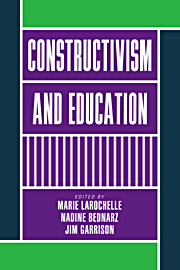Book contents
- Frontmatter
- Contents
- Preface
- List of contributors
- I Introduction
- II From epistemological constructivism to teaching: a variety of views
- III Teaching within the constructivist mode: practices and promises
- IV The mediating role of teachers and teacher education
- 12 Sociocultural perspectives on the teaching and learning of science
- 13 Remarks on the education of elementary teachers
- 14 Constructivism as a referent for reforming science education
- V Conclusion
- Notes
- References
- Index
14 - Constructivism as a referent for reforming science education
Published online by Cambridge University Press: 04 August 2010
- Frontmatter
- Contents
- Preface
- List of contributors
- I Introduction
- II From epistemological constructivism to teaching: a variety of views
- III Teaching within the constructivist mode: practices and promises
- IV The mediating role of teachers and teacher education
- 12 Sociocultural perspectives on the teaching and learning of science
- 13 Remarks on the education of elementary teachers
- 14 Constructivism as a referent for reforming science education
- V Conclusion
- Notes
- References
- Index
Summary
Since World War II, mathematics and science education have been high on the educational reform agenda in many countries, including the United States. As the century comes to a close, the dominant approach to reform involves establishing for schools common “standards” for subject matter content and teaching practice, even though this kind of top-down approach does not stand up to scrutiny. For example, since the mid-eighties, following publication of A Nation at Risk by the National Commission on Excellence in Education (NCEE, 1983), funding for reform initiatives has been increasing. To be sure, commentators have noted “modest gains” in student performance on standardized tests, particularly among African-American students (Suter, 1993). Others point out, however, that science still is “not taught frequently in many schools,” and “many children tend to lose interest in science at about the fourth grade” (Sivertsen, 1993). Overall, researchers continue to paint a fairly dismal picture of the state of science and mathematics teaching in U.S. schools (Roychoudhury, 1994). In the elementary grades particularly, science often is neglected, and when it is taught, the textbook often is the sole source of the curriculum, and “stand-and-deliver” teaching methods eclipse all else in classroom practice. Researchers describe typical lessons as dominated by teacher talk, with much emphasis on memorization and (in mathematics) computation (Gallas, 1995; Lemke, 1990).
In other words, despite the gains in standardized test results, few American students attain higher levels of achievement in mathematics or science (National Center for Education Statistics, NCES, 1996). Further, the gap between the achievement (i.e., the test scores) of whites and minority children has persisted.
- Type
- Chapter
- Information
- Constructivism and Education , pp. 233 - 250Publisher: Cambridge University PressPrint publication year: 1998
- 10
- Cited by

